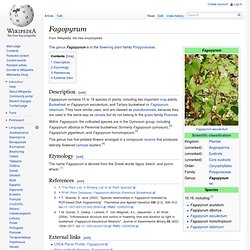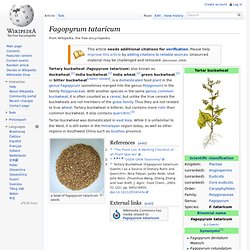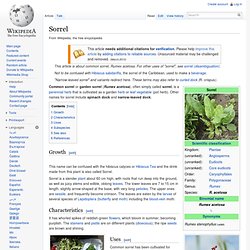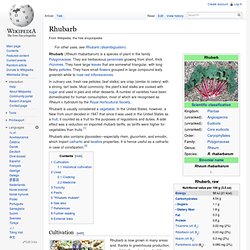

Fagopyrum. The genus Fagopyrum is in the flowering plant family Polygonaceae.

Description[edit] Fagopyrum contains 15 to 16 species of plants, including two important crop plants, Buckwheat or Fagopyrum esculentum, and Tartary buckwheat or Fagopyrum tataricum. They have similar uses, and are classed as pseudocereals, because they are used in the same way as cereals but do not belong to the grass family Poaceae. Within Fagopyrum, the cultivated species are in the Cymosum group, including Fagopyrum dibotrys or Perennial buckwheat (formerly Fagopyrum cymosum),[2] Fagopyrum giganteum, and Fagopyrum homotropicum.[3] Etymology[edit] The name Fagopyrum is derived from the Greek words fagos, beech, and pyron, wheat. [1]
Fagopyrum tataricum. Tartar buckwheat was domesticated in east Asia.

While it is unfamiliar to the West, it is still eaten in the Himalayan region today, as well as other regions in Southwest China such as Guizhou province. Sorrel. "Narrow-leaved sorrel" and variants redirect here.

These terms may also refer to curled dock (R. crispus). Flowering sorrel. Common sorrel or garden sorrel (Rumex acetosa), often simply called sorrel, is a perennial herb that is cultivated as a garden herb or leaf vegetable (pot herb). Other names for sorrel include spinach dock and narrow-leaved dock. Growth[edit] Sorrel (aveluk in Armenian) picked fresh from Mount Ara and braided before selling for ease of drying and extended use.
This name can be confused with the hibiscus calyces or Hibiscus Tea and the drink made from this plant is also called Sorrel. Hyogo,Japan Characteristics[edit] It has whorled spikes of reddish-green flowers, which bloom in summer, becoming purplish. Uses[edit] Common sorrel has been cultivated for centuries. Buckwheat. Field of buckwheat in Bumthang (Bhutan) Buckwheat (Fagopyrum esculentum) is a plant cultivated for its grain-like seeds and as a cover crop.

To distinguish it from a related species, Fagopyrum tataricum, it is also known as Japanese buckwheat[2] and silverhull buckwheat.[2] Despite the name, buckwheat is not related to wheat, as it is not a grass. Instead, buckwheat is related to sorrel, knotweed, and rhubarb. Because its seeds are eaten and rich in complex carbohydrates, it is referred to as a pseudocereal. Etymology[edit] The name 'buckwheat' or 'beech wheat' comes from its triangular seeds, which resemble the much larger seeds of the beech nut from the beech tree, and the fact that it is used like wheat.
Polygonum. Polygonum is a genus in the Polygonaceae family.

Common names include knotweed, knotgrass, bistort, tearthumb, mile-a-minute, and several others. In the Middle English glossary of herbs "Alphita" (ca. 1400-1425), it was known as ars-smerte.[1] There have been various opinions about how broadly the genus should be defined. For example, Buckwheat has sometimes been included in the genus. The genus primarily grows in northern temperate regions. They vary widely from prostrate herbaceous annual plants under 5 cm high, others erect herbaceous perennial plants growing to 3–4 m tall, and yet others perennial woody vines growing to 20–30 m high in trees. The genus name is from the Greek poly, "many" and gonu, "knee" in reference to the swollen jointed stem. Polygonum species are occasionally eaten by humans, and are used as food plants by the larvae of some Lepidoptera species - see list. Rhubarb. In culinary use, fresh raw petioles (leaf stalks) are crisp (similar to celery) with a strong, tart taste.

Most commonly, the plant's leaf stalks are cooked with sugar and used in pies and other desserts. A number of varieties have been domesticated for human consumption, most of which are recognised as Rheum x hybridum by the Royal Horticultural Society. Rhubarb is usually considered a vegetable. In the United States, however, a New York court decided in 1947 that since it was used in the United States as a fruit, it counted as a fruit for the purposes of regulations and duties. A side effect was a reduction on imported rhubarb tariffs, as tariffs were higher for vegetables than fruits.[1]